 1 Thursday 8 July, 2010 The name Paris derives from that of its earliest inhabitants, the Gaulish tribe known as the Parisii. The city was called Lutetia during the Roman era of the 1st to the 6th century, but during the reign of Julian the Apostate, (360–363) the city was renamed Paris. We spend all of today touring the city's famous sights. |
 2 Thursday 8 July, 2010 We checked out of the Hotel L'Avre and left our luggage at the Ibis. We asked the man at the desk how far to the Eiffel Tower. 'About 10-15 minutes' walk he said. So off we went passing by the Ecole Militaire - the Military School. |
 3 Thursday 8 July, 2010 We enter the Champ de Mars and get our first real look at the Eiffel Tower. |
 4 Thursday 8 July, 2010 The park is named after the Campus Martius (Mars Field) in Rome, a tribute to the Roman god of war. The lawns here were formerly used as drilling and marching grounds by the French military. |
 5 Thursday 8 July, 2010 Originally, the Champ de Mars was part of a large flat open area called Grenelle that was reserved for market gardening. However, it was not an especially fertile place for farming. |
 6 Thursday 8 July, 2010 About 25 minutes into our "10-15 minute walk", we reached the base of the tower. |
 7 Thursday 8 July, 2010 It was about 9:00 am and going up the tower was on my must do list; I really wanted to see the view from the top or even the first platform. |
 8 Thursday 8 July, 2010 But even at this early hour, the queues were very long and getting longer. |
 9 Thursday 8 July, 2010 When you get to the front of the queue, the sign tells you that the average waiting time from here is thirty minutes. |
 10 Thursday 8 July, 2010 I didn't come to Paris to wait for hours in extreme heat to do this, so we gave up and thought it might be less crowded at night time. Hah! |
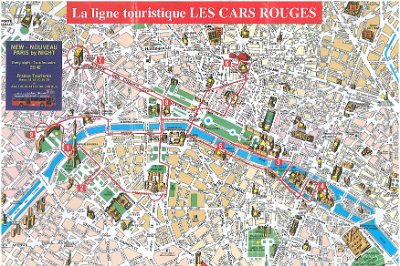 11 Thursday 8 July, 2010 Very near the tower (at Point 1) , a red hop-on hop-off bus was waiting. It cost us €25 each valid for the next two days. |
 12 Thursday 8 July, 2010 The commentary was in English and many other languages. I sat near a couple of women who talked loudly and looked at nothing. I'm starting already to develop a distaste for tourists. |
 13 Thursday 8 July, 2010 After boarding the bus we cross over and (come back immediately) over the Pont d'Iéna (Jena Bridge), a bridge spanning the River Seine. It links the Eiffel Tower on the Left Bank to the district of Trocadéro on the Right Bank. |
 14 Thursday 8 July, 2010 In 1807, Napoléon I ordered the construction of a bridge overlooking the Military School. He named the bridge after his victory in 1806 at the Battle of Jena, where some 28,000 Prussians were killed (to France's 2,480) after which France occupied Prussia. The Seine is not at all clean. |
 15 Thursday 8 July, 2010 The bus takes us to Avenue Joseph Bouvard, a road between the Eiffel Tower and the Ecole Militaire, where we pick up more passengers. |
 16 Thursday 8 July, 2010 We pass by the Hotel Des Invalides (National Residence of the Invalids) which contains museums and monuments relating to the military history of France. |
 17 Thursday 8 July, 2010 The buildings house the Musée de l'Armée, the Musée des Plans-Reliefs, and the Musée d'Histoire Contemporaine. The Invalides also contain the burial sites for some of France's war heroes, notably Napoleon Bonaparte. |
 18 Thursday 8 July, 2010 The Musée d'Histoire Contemporaine is a museum of contemporary history located in the Invalides. The museum was originally established in 1914 as the Library-Museum of War. Today the museum contains about 1,500,000 items and documents from 1870 to the present day, covering major themes of French or international history |
 19 Thursday 8 July, 2010 Our tour continues over an arch bridge, the Pont Alexandre III which is the most ornate bridge in Paris. It is named after Tsar Alexander III, who had concluded the Franco-Russian Alliance in 1892. |
 20 Thursday 8 July, 2010 The bridge was built between 1896 and 1900 and features Art Nouveau lamps, cherubs, nymphs and winged horses at either end. The style of the bridge reflects that of the Grand Palais on the right bank. The bridge behind is the Pont des Invalides. |
 21 Thursday 8 July, 2010 The Grand Palais on the right bank near the Pont Alexandre III. The Great Palace is a large historic site, exhibition hall and museum complex located at the Champs-Élysées |
 22 Thursday 8 July, 2010 We continue past the Grand Palace and turn right into the Champs Elysees. |
 23 Thursday 8 July, 2010 At the eastern end of the Champs Elysees we turn right into Place de la Concorde. The Place de la Concorde (Harmony Square) is one of the major public squares in Paris and at 86,400 square metres, the largest. The imposing building behind is the Hotel de Crillon. It served as the headquarters of the occupying German army during World War II. |
 24 Thursday 8 July, 2010 During the French Revolution of July 1789, the statue of Louis XV of France was torn down and the area was renamed "Place de la Révolution". The new revolutionary government erected the guillotine in the square, and it was here that King Louis XVI was executed on January 21, 1793. Temporary stands are erected to celebrate the forthcoming Bastile Day only six days from now. |
 25 Thursday 8 July, 2010 Other important figures guillotined on the site were Queen Marie Antoinette on 16 October 1793, Princess Élisabeth of France (her sister-in-law) and many others. The other imposing building, identical to the Hotel de Crillon, is the French Naval Ministry. |
 26 Thursday 8 July, 2010 We drive past the southern wall of the Musee du Louvre. |
 27 Thursday 8 July, 2010 A little farther along the Quai Francois Mitterand we see the Église Saint-Germain l'Auxerrois . Back when the Louvre was still a royal palace, Saint-Germain l'Auxerrois was its church. |
 28 Thursday 8 July, 2010 We then cross the river on the Pont Neuf (New Bridge) which, despite its name, is the oldest standing bridge across the river Seine. Its name, which was given to distinguish it from older bridges that were lined on both sides with houses, has remained. Behind is the The French Cour de cassation (highest jurisdiction in the French judicial order). The building is part of the Palais de Justice. |
 29 Thursday 8 July, 2010 The Notre Dame de Paris (Our Lady of Paris) is a Gothic, Catholic cathedral on the eastern half of the Île de la Cité. It is the church that contains the official chair of the Archbishop of Paris. |
 30 Thursday 8 July, 2010 Huge crowds gather in the heat. |
 31 Thursday 8 July, 2010 Bus stop number 4 is outside the Quasimodo schlock shop. Quasimodo was the Hunchback of Notre Dame in the novel by Victor Hugo. |
 32 Thursday 8 July, 2010 We do not cross the Pont d'Arcole. It is a bridge that connects the Ile de la Cite (the island where Paris was founded) to the city hall (the Hôtel de Ville). City Hall houses the City of Paris's administration and it has been the location of the municipality of Paris since 1357. Since 1977, the office of the Mayor of Paris has been located here. |
 33 Thursday 8 July, 2010 We're back at the Palias de Justice and the ancient structure of the Conciergerie, a former prison, and now a museum. This is where Marie Antoinette was imprisoned before being executed on the guillotine. |
 34 Thursday 8 July, 2010 The Marais (Hôtel de Sens) is one of the rare neighbourhoods almost completely untouched by the Haussmann renovations. |
 35 Thursday 8 July, 2010 We cross Pont Saint-Michele and return to the left bank. Pont Saint-Michel links the Place Saint-Michel on the left bank to the Île de la Cité. It was named after the nearby chapel of Saint-Michel and the 62 metre long bridge dates to 1857. Pont Neuf is also visible in this picture. |
 36 Thursday 8 July, 2010 Once on the left bank, we drive beside the Seine. This is the Pont Neuf again connecting the left bank with the Île de la Cité. The limestone from which the bridge is made was mined from deposits under the city itself. The blocks were cut to size underground and pulleyed to the surface. Limestone is made from the skeletons of dead sea creatures compressed over millions of years. This means that Paris was once at the bottom of a sea bed. |
 37 Thursday 8 July, 2010 The pedestrian bridge, the Pont des Arts, with the Louvre in the background. The famous pyramid is in the courtyard behind. |
 38 Thursday 8 July, 2010 To the left of the Pont des Arts is the Institut de France. The institute manages approximately 1,000 foundations, museums and chateaux. It also awards prizes and subsidies, which amounted to a total of €5,028,190.55 in 2002. |
 39 Thursday 8 July, 2010 This seems to be a company registered on the Paris Stock Exchange. |
 40 Thursday 8 July, 2010 Our bus tour continues along Quai Malaquais on the left bank and crosses the river again at the Pont de la Concorde where we again see the Egyptian monolith. The Luxor obelisk is decorated with hieroglyphics exalting the reign of the pharaoh Ramses II. It is one of two the Egyptian government gave to France in the nineteenth century. |
 41 Thursday 8 July, 2010 This is the L'église de la Madeleine ( Madeleine Church) a Roman Catholic church. It was designed in 1806 as a temple to the glory of Napoleon's army and Napoleon himself. After the fall of Napoleon in 1814, King Louis XVIII determined that the structure would be used as a church, dedicated to Mary Magdalene. |
 42 Thursday 8 July, 2010 One of our red buses is opposite us at stop number 6. This is the Palais Garnier but it is more commonly known as the Paris Opéra. |
 43 Thursday 8 July, 2010 The Palais Garnier is a 2,200-seat opera house on the Place de l'Opéra which was the primary home of the Paris Opera from 1875 until 1989. It was designed by Charles Garnier in Neo-Baroque style and is regarded as one of the architectural masterpieces of its time. |
 44 Thursday 8 July, 2010 In 1896, the falling of one of the counterweights for the grand chandelier resulted in the death of a person. This incident, the underground lake, cellars and other elements of the Opera House were the inspirations for Gaston Leroux's classic 1910 novel, The Phantom of the Opera. |
 45 Thursday 8 July, 2010 We continue our bus tour but by now the traffic and the heat are unbearable, so we alight at stop 7, the Arc de Triomphe. We find an air-conditioned cafe and have lunch. After lunch, we thought it would be nice to go to the top of the Arch, but once again the summer holiday crowds were overwhelming so we gave up seeing yet another Paris icon. |
 46 Thursday 8 July, 2010 The Arc de Triomphe honours those who fought and died for France in the French Revolutionary and Napoleonic Wars. The names of all French victories and generals are inscribed on its inner and outer surfaces. Underneath its vault lies the Tomb of the Unknown Soldier from World War I. |
 47 Thursday 8 July, 2010 The large sculptural relief on the left is Le Triomphe de 1810 featuring a resplendent Napoleon and above it is La bataille d'Aboukir, 1799. On the right is Le Départ de 1792 (La Marseillaise) with naked French youth fighting bearded German soldiers in chain mail and above it the Les funérailles du général Marceau, 1796. The reliefs at the top glorify the battles of Jemmappes and Austerlitz. |
 48 Thursday 8 July, 2010 Napoleon commissioned the arch in 1806 after the victory at Austerlitz but it was not completed until the reign of King Louis-Philippe between 1833 and 1836. On 15 December 1840, Napoleon's remains (brought back to France from Saint Helena) passed under it on their way to the Emperor's final resting place at the Invalides. |
 49 Thursday 8 July, 2010 We then walk down what must be the world's most splendid esplanade, the Avenue des Champs-Élysées. The avenue runs for 2 kilometers from the Place de la Concorde to the Arc de Triomphe. The Champs-Élysées forms part of the Axe historique. |
 50 "Thursday 8 July, 2010 The name is French for Elysian Fields, the place of the blessed dead in Greek mythology. The Champs-Élysées was the site of several notable military parades, the most infamous being the march of German troops celebrating the Fall of France on 14 June 1940. The two most famous subsequent marches were of Free French and American forces after the liberation of the Paris in 1944. |
 51 Thursday 8 July, 2010 When Jenni and Alison visited Paris in October 2006, they stopped for a hot chocolate at this very expensive establishment on the Champs-Élysées. It was special for Alison as she and Bob stopped there when they were in Paris together. |
 52 Thursday 8 July, 2010 Near Franklin D Roosevelt circle is the Artcurial building. It is an outlet for contemporary art housed in a 19th century mansion. |
 53 Thursday 8 July, 2010 The avenue is lined with horse-chestntnut trees and on the left are the stands erected to celebrate Bastille day on 14 July, six days from now. |
 54 Thursday 8 July, 2010 We walk farther along the Champs Elysees and turn into the corner of Avenue du General Eisenhower and Avenue Winston Churchill where we get our first glimpse of the Grand Palais. |
 55 Thursday 8 July, 2010 Opposite the Palais is a 3.6m-tall bronze statue depicting General Charles de Gaulle in full uniform marching to the Arc de Triomphe in a liberated Paris on 26 August 1944. On June 18 1940, speaking from the BBC in London, De Gaulle declared that the war for France was not yet over and rallied the country in support of the Resistance. It is one of the most important speeches in French history. |
 56 Thursday 8 July, 2010 A bronze quadriga (car or chariot drawn by four horses) tops each wing of the main façade. The one above depicts Immortality prevailing over Time. The one on the Seine side that we saw earlier today, depicts Harmony triumphing over Discord. |
 57 Thursday 8 July, 2010 The Blue/White/Red tricolour flies from the top of the Grand Palais. The flag first appeared during the French Revolution in 1789 and the colors have come to represent liberty, equality, and fraternity - all ideals associated with the French Revolution. |
 58 Thursday 8 July, 2010 The Grand Palais is a large historic site, exhibition hall and museum complex. After demolishing the Palace of the Industry, construction began in 1897 as part of the works for the Universal Exposition of 1900. These works also included the creation of the adjacent Petit Palais and Pont Alexandre III. |
 59 Thursday 8 July, 2010 The exterior combines an imposing Classical stone façade with Art Nouveau ironwork, and a number of allegorical statue groups. |
 60 Thursday 8 July, 2010 The grand inauguration took place on May 1, 1900. |
 61 Thursday 8 July, 2010 The entrance is quite stunning. The building has a history of needing to be repaired, the last time in 2007. It was again being repaired while we were there. |
 62 Thursday 8 July, 2010 Opposite the Grand Palais is the Petit Palais (Small Palace). It is a museum built for the Universal Exhibition in 1900 and it now houses the City of Paris Museum of Fine Arts. The tympanum (architectural element located within an arch) depicts the city of Paris surrounded by muses (goddesses who inspire the creation of literature and the arts). |
 63 Thursday 8 July, 2010 At the time of our visit, the Petit Palias was hosting an exhibition of YSL's fashions. Yves Mathieu-Saint-Laurent was born in 1936 in Oran, Algeria, which at the time was a French colony. |
 64 Thursday 8 July, 2010 Red Bus stop 8 is nearby so we hop-on and cross the Pont Alexandre III again. |
 65 Thursday 8 July, 2010 We travel along the left bank for a while and then cross the Pont de L'Alma back to the right bank. |
 66 Thursday 8 July, 2010 We get off the bus at stop 9 at a place called the Trocadero. The place is filthy and there are pests everywhere flogging trashy souvenirs. However, the view of the Eiffel Tower is superb. |
 67 Thursday 8 July, 2010 It was here, with the Eiffel Tower in the background, that Adolf Hitler was pictured during his short tour of the defeated city in 1940. This became an iconic image of the Second World War. |
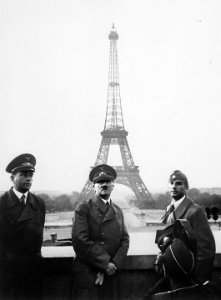 68 Thursday 8 July, 2010 One of the many pictures of Adolf Hitler taken in June 23, 1940 when he visited Paris with architect Albert Speer (left) and artist Arno Breker (right). Interesting note: This image from the US National Archives and Records Administration (NARA) was originally copyrighted by the Presse Illustrationen Hoffmann Berlin and was seized by the US government after World War II and vested by the United States Attorney General as US government property in 1951. It is now considered public domain. |
 69 Thursday 8 July, 2010 The heat and old age are draining us so we decide to return to the Ibis and check in. Nearby is the Trocadero Metro station. The railway staff are helpful and speak English. We buy ten single-use tickets for €1 each. |
 70 Thursday 8 July, 2010 We caught the 6 line train to Cambronne very near our new lodgings. The trains are old and not air-conditioned but there is a train every few minutes. |
 71 Thursday 8 July, 2010 A curious thing about the 6 line trains is that they are fitted with rubber wheels. They were neither quiet nor smooth but I suppose, being an elevated train, the wheels do not echo across the buildings like steel wheels would have done. Who knows? |
 72 Thursday 8 July, 2010 The Cambronne Metro reminded us of the elevated steel railway structures down the streets of Chicago. |
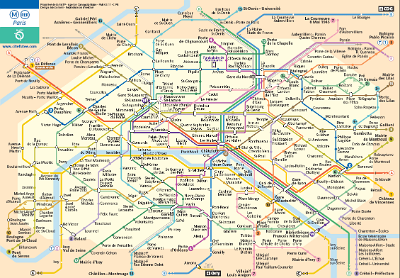 73 Thursday 8 July, 2010 We caught the 6 line train 2 stations south to Pasteur. Here we changed trains and caught the 12 line train to Abbesses. |
 74 Thursday 8 July, 2010 We alight at Pasteur station to catch the 12 line train. Just follow the green 12 symbol to find the correct platform. At Abbesses station it was a short walk to the funicular that took us to . . . |
 75 Thursday 8 July, 2010 . . . the Basilique Sacré-Coeur (Basilica of the Sacred Heart), a Roman Catholic church, located on the highest point of Paris in Montmartre. |
 76 Thursday 8 July, 2010 The steps to the Sacré-Cœur were crowded with people. A singer, visible halfway up the steps, entertained the masses. |
 77 Thursday 8 July, 2010 Sacratissimo Cordi Jesu - Sacred heart of Jesus. About the Sacré-Cœur: foundation stone laid in 1875, consecrated in 1891, fully completed in 1914 and elevated to the status of a basilica in 1919 after the end of the First World War. |
 78 Thursday 8 July, 2010 The site of the basilica is traditionally associated with the beheading of the city's patron, Saint Denis, in the 3rd century. According to legend, after he was martyred here, Bishop Denis picked up his severed head and carried it several miles to the north, where the suburb of Saint-Denis stands today. Saint Denis was one of many cephalafores in ancient legend. |
 79 Thursday 8 July, 2010 Most of Paris' landmarks can be seen from the Sacré-Coeur. |
 80 Thursday 8 July, 2010 The triple-arched portico is surmounted by two bronze equestrian statues of two of France's four national saints, Joan of Arc and King Saint Louis IX (St Louis, Missouri was named after him). |
 81 Thursday 8 July, 2010 A climb to the top of the dome provides an excellent view of Paris. At 271 feet above Montmartre, it is the second highest viewpoint after the Eiffel Tower. We chose not to do the climb. |
 82 Thursday 8 July, 2010 It's now 8:00 pm. We leave the Sacré-Coeur and enter the Montmartre area where we get a glimpse of the Eiffel Tower. |
 83 Thursday 8 July, 2010 We wander through Montmartre and pick up cherry ice creams on the way. |
 84 Thursday 8 July, 2010 We wander down the hill where we catch the 12-line train to Concorde and change to the 1-line for the Louvre station. |
 85 Thursday 8 July, 2010 We emerge at the Louvre Metro station . . . |
 86 Thursday 8 July, 2010 . . . and enter the Louvre, justly famous as the site of Dan Brown's 'Da Vinci Code' pyramid. It also contains lesser known works such as the Mona Lisa and the Venus de Milo. |
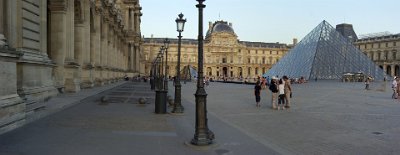 87 Thursday 8 July, 2010 The Louvre is one of the world's largest museums, the most visited art museum in the world and a historic monument. Nearly 35,000 objects from prehistory to the 19th century are exhibited over an area of 60,600 square metres. |
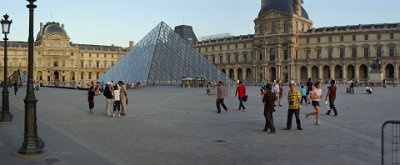 88 Thursday 8 July, 2010 In 1983, French President François Mitterrand presented a plan to renovate the building. A glass pyramid was proposed to stand over a new entrance in the main court, the Cour Napoléon. The pyramid and its underground lobby were inaugurated on 15 October 1988. The second phase of the plan, The Inverted Pyramid, was completed in 1993. By 2002, attendance had doubled. |
 89 Thursday 8 July, 2010 The museum is housed in the Louvre Palace (Palais du Louvre) which began as a fortress built in the late 12th century under Philip II. Remnants of the fortress are still visible. The building was extended many times to form the present Louvre Palace. |
 90 Thursday 8 July, 2010 No wonder there was a revolution. To use this palace to store royalty's treasures, while residing in the Versailles Palace is extravagance and provocation in the extreme. "Let them eat cake" indeed. |
 91 Thursday 8 July, 2010 Fortunately, the Louvre is closed so I don't have to battle the millions of tourists (not an art lover among them) who come here to see the Mona Lisa. |
 92 Thursday 8 July, 2010 The Eiffel Tower and the Arc de Triomphe du Carrousel silhouetted against the setting sun. |
 93 Thursday 8 July, 2010 The Arc de Triomphe du Carrousel is located in the Place du Carrousel on the site of the former Tuileries Palace. The Arc de Triomphe du Carrousel was built between 1806-1808 to commemorate Napoleon's military victories of the previous year. The more famous Arc de Triomphe de l'Étoile was designed in the same year, but it took thirty years to build and is about twice as massive. |
 94 Thursday 8 July, 2010 The Arc de Triomphe du Carrousel is at the eastern end of the Axe historique, a nine kilometre long linear route. Looking west, the arch is perfectly aligned with the obelisk in the Place de la Concorde (visible here), the centerline of the Champs-Élysées and the Arc de Triomphe (also visible). When the Tuileries was burned down in 1871, the view was opened from the Place du Carrousel and the Louvre. |
 95 Thursday 8 July, 2010 Louis XIV, patron of the arts, was King of France and of Navarre from 1643 until his death in 1715. His reign began at the age of four and lasted seventy-two years, three months, and eighteen days, and is the longest documented reign of any European monarch. |
 96 Thursday 8 July, 2010 We exit the Louvre via the exit that joins the Pont du Carousel. |
 97 Thursday 8 July, 2010 How surprising to see Napoleon III glorifying himself again. |
 98 Thursday 8 July, 2010 We're on the Quai Francois Mitterand on the right bank of the Seine. Mitterand was first elected during the 1981 presidential election. He became the first socialist President of the Fifth Republic, and the first left-wing head of state since 1954. He is to date the only member of the Socialist Party to be elected President of France. |
 99 Thursday 8 July, 2010 We're looking more to the east to the Pont des Arts pedestrian bridge and the Île de la Cité behind it. |
 100 Thursday 8 July, 2010 Looking to the west we can see the sun setting over the Pont Royale. |
 101 Thursday 8 July, 2010 We cross the Pont du Carousel which is the the bridge, with its three arches, that inspired the architects of the Trianna Bridge in Seville, Spain. We head for the closest train station at Musee d'Orsay. |
 102 Thursday 8 July, 2010 Quai Voltaire on the left bank. One way street of course because the French drive on the RH side of the road. |
 103 Thursday 8 July, 2010 We walk along Quai Voltaire on the left bank and look across the Pont Royale and see the Ecole de Louvre. |
 104 Thursday 8 July, 2010 Very late in the day, we arrive at the Musee d'Orsay. |
 105 Thursday 8 July, 2010 It is closed but this is on Jenni's must-see list. Interesting aside: The billboard in front of us is advertising a Vincent Van Gogh exhibition. One of the most popular episodes of Doctor Who is called Vincent and the Doctor. In this episode the Doctor and Amy travel back in time to meet Van Gogh and save him from a scary monster. Van Gogh is an artistic failure in his life time; nobody buys his paintings. The episode finishes on a touching scene where the Doctor and Amy bring Van Gogh back to the Musee d'Orsay in 2010 to show him how he is now regarded as one of the world's great masters. Van Gogh then goes back to his own time and commits suicide just as history tells us. The scenes in the Musee d'Orsay were actually shot in The National Museum, Cardiff. The story aired on 26/06/2010 and it was one of the best and most popular episodes ever. |
 106 Thursday 8 July, 2010 Opposite the Musee d'Orsay is an RER station (Réseau Express Régional, "Regional Express Network"). The RER is a rapid transit system that serves Paris and its suburbs. Sadly, the trains were heavily disfigured with graffiti. We caught this train to the Eiffel Tower RER station. |
 107 Thursday 8 July, 2010 Exhausted, we decided we needed a snack and a coffee. We went indoors, because for all the romanticism of Paris’ cafes, the outdoor dining is filled with smokers – especially young women. Shock, horror, the prices were astronomical so we decided we were not very hungry and had a couple of cappuccinos: €13 or $20 in our money for two very ordinary small cappuccinos. Ouch! |
 108 Thursday 8 July, 2010 Then we headed for the tower. Beautiful by day, it is magnificent at night. |
 109 Thursday 8 July, 2010 By now it's about 10:00 pm and finally starting to get dark - it's still light at 9:30 at this time of the year. |
 110 Thursday 8 July, 2010 Unfortunately, the crowds that seemed extreme during the morning were more so now. I then accepted that I was never to see Paris from the Eiffel Tower. |
 111 Thursday 8 July, 2010 Crowded and still very hot. A magnificent city ruined by its popularity. |
 112 Thursday 8 July, 2010 Huge crowds gathered on the Champ de Mars and we thought it was to escape the heat. Pests were still out selling junk, this time a thing fired into the air that left a blue streak of light behind it. |
 113 Thursday 8 July, 2010 It had a pleasant, relaxed atmosphere to it. We sat around and enjoyed it for a while. |
 114 Thursday 8 July, 2010 It was very crowded near the Ecole Militiare. There were picnics and barbecues and everyone seemed to be having a good time. |
 115 Thursday 8 July, 2010 We had almost left the Champs de Mars when, at 11:00 pm, the reason for the crowds became clear . . . |
 116 Thursday 8 July, 2010 . . . the nightly light show. |
 117 Thursday 8 July, 2010 Lights twinkle on and off and the display is very much like fireworks. |
 118 Thursday 8 July, 2010 Towards the end of the show, the tower seems to be ablaze. Next stop: Our second day in ParisSummary at the the end of our first day in Paris: Wow! What a city. But the summer crowds spoil too much of it. |